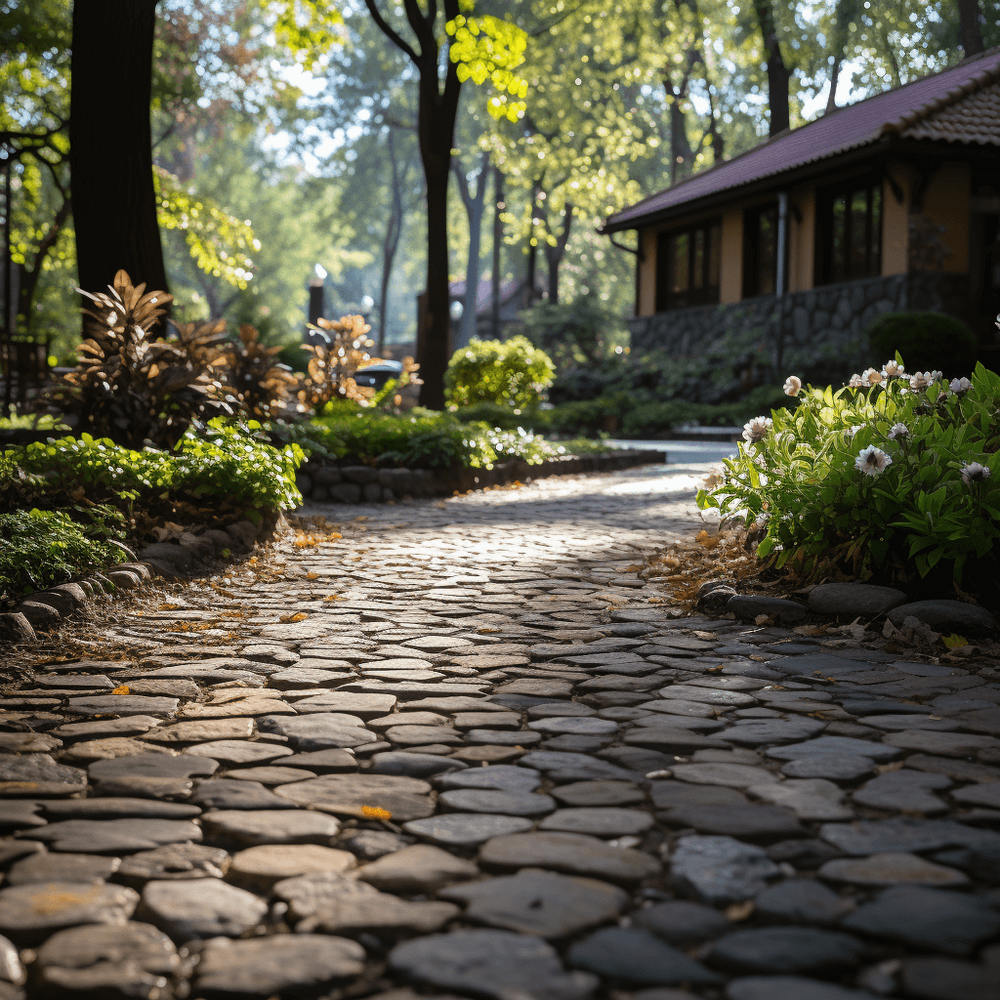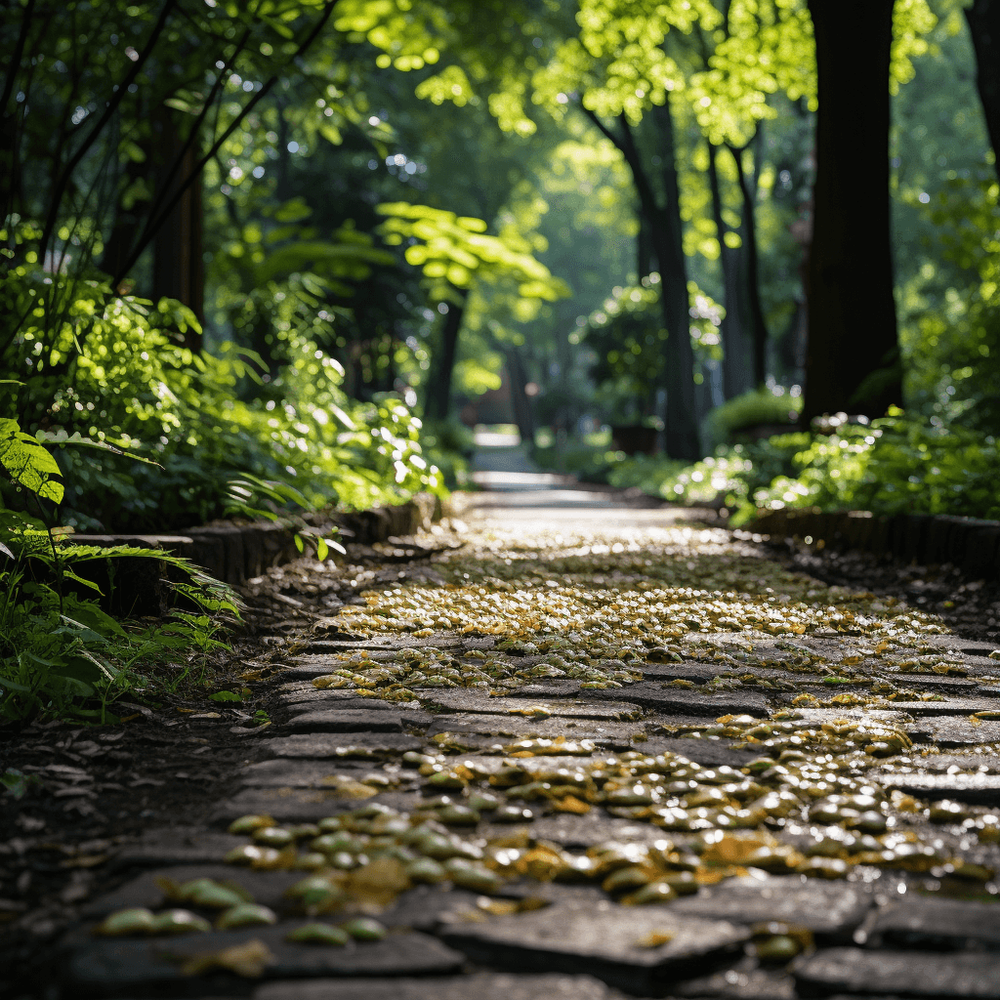
Paver patios and walkways are an attractive feature for any home, but weeds can quickly turn them into a frustrating eyesore. Worry not – we have you covered with our complete guide to effectively eliminate those pesky weeds between pavers.
n
From tried-and-true manual methods to eco-friendly alternatives, this blog post is here to help you restore your outdoor oasis and keep it weed-free.
Key Takeaways
- n
- Weeds between pavers can be unsightly and damaging, but there are several effective methods to eliminate them, including manual removal, chemical herbicides (with caution), and natural remedies like vinegar or boiling water.
- Preventative measures such as regular cleaning and maintenance, using polymeric sand or jointing compound, planting ground covers or moss, and proper sealing can help prevent weed growth altogether.
- Regular sweeping and cleaning are essential for maintaining a weed-free area; reapplying treatments periodically may also be necessary to keep weeds at bay.
- Professional landscaping companies can offer helpful services like regular maintenance and eco-friendly herbicide application if necessary.
n
n
n
n
Why It Is Important To Get Rid Of Weeds Between Pavers
Ah, the joy of beautiful paving stones adorning your Arizona home’s landscape. But wait – what’s that? Weeds sprouting in between those gorgeous ,pavers! Eliminating these pesky intruders is essential for several reasons.
n
Moreover, as they steadily grow and spread their roots deep within the paver joints, these unwelcome guests can cause significant damage to your hardscape over time. From dislodging individual pavers and causing uneven surfaces to create routes for water penetration leading to erosion – weed growth threatens the structural integrity of your investment.
n
Finally, safety concerns arise because some common Arizona weeds like puncture vines (commonly known as goatherds) sport sharp spines with the potential to injure both people and pets alike when walking on them.
n
Plus, allergies are further exacerbated by pollen-producing weed varieties such as ragweed or tumbleweed.

Common Methods To Eliminate Weeds Between Pavers
Discover the top three common methods to eliminate weeds between pavers, including manual removal, chemical herbicides, and natural weed control methods.
Manual Removal
If you’re looking for an eco-friendly and cost-effective way to eliminate weeds between your pavers, then manual removal is the way to go. This involves physically pulling or digging out the weeds using your hands or specialized tools like a weed picker.
n
It’s important to remove all parts of the weed, including the roots, to prevent regrowth. While this method can be time-consuming and labor-intensive, it’s also a great workout! Plus, it allows you to get up close and personal with your outdoor space, which is always a good thing.
Chemical Herbicides
Applying chemical herbicides can be a highly effective way to get rid of weeds between pavers. However, these products come with potential health risks and environmental concerns.
n
There are different types of chemical herbicides available, including pre-emergent and post-emergent formulas. Pre-emergent herbicides prevent weed seeds from germinating while post-emergent ones kill existing weeds.
n
Keep in mind that some products may not be suitable for all types of paving stones, so it’s best to consult with a professional landscaping company or supplier before making a purchase.
Natural Weed Control Methods
Another effective method to eliminate weeds between pavers is by using natural weed control methods. These methods are a great alternative for those who prefer an eco-friendly approach or don’t want to use chemical herbicides.
n
Boiling water, vinegar, and salt solutions are some of the most popular natural remedies used to kill weeds.
n
Additionally, planting moss or ground covers between pavers can prevent weed growth altogether by leaving no space for weeds to grow in. Moss also absorbs moisture that’s partly responsible for maintaining weed seeds’ viability; hence it makes it harder for new plants to take root in your patio area.

Preventative Measures To Prevent Weed Growth Between Pavers
Regular cleaning and maintenance, using polymeric sand or jointing compound, planting ground covers or moss, and proper sealing are effective ways to prevent weed growth between pavers.
Regular Cleaning And Maintenance
Regular cleaning and maintenance are critical to preventing weed growth between pavers. Regular sweeping and cleaning help remove any debris that can accumulate in the joints or between the pavers, which can provide an ideal environment for weeds to grow.
n
Also, keeping your patio or driveway clean helps reduce moisture build-up, which can also encourage weed growth. As part of regular maintenance, consider using a power washer to remove any existing sand from the joints and replace it with polymeric sand or jointing compound designed for use in paver applications.
n
In addition to regular cleaning, other preventative measures include planting ground covers like thyme or moss between pavers instead of leaving bare spaces; applying a sealant after pressure washing; and using specific tools such as weeding knives to remove any weeds manually before they have time to establish themselves fully.
Use Of Polymeric Sand Or Jointing Compound
Another effective way to prevent weed growth between paving stones is through the use of polymeric sand or jointing compound. These materials are specially designed for filling the gaps between pavers, creating a solid and stable base that helps prevent weeds from taking root.
n
Polymeric sands and jointing compounds come in different colors to match your paver’s natural hues, providing an aesthetically pleasing finish while simultaneously keeping pesky weeds at bay.
n
Not only do they help with weed control, but they also offer additional benefits like better drainage and improved stability for your patio or walkway.
Planting Ground Covers Or Moss
Another effective way to prevent weed growth between pavers is by planting ground covers or moss. These low-growing plants can cover the spaces between the pavers, leaving no room for weeds to grow.
n
Plus, they add a beautiful touch of greenery to your outdoor space.
n
In addition to preventing weeds from growing, ground covers and moss also help improve soil quality by adding nutrients and retaining moisture. They are resilient in hot weather conditions and require little maintenance once established.
Proper Sealing
Proper sealing of pavers is a crucial preventative measure to stop weed growth in its tracks. Sealing creates a barrier that prevents weeds from taking root and germinating between the joints of your pavers.
n
It also helps protect your paver surfaces from stains, weathering, and erosion caused by foot traffic or extreme weather conditions. Using high-quality sealants can help ensure that the protective coating lasts longer, offering better resistance against water penetration and other pollutants that may encourage weed growth over time.

Tips For Maintaining A Weed-Free Paver Area
Regular sweeping and cleaning are essential to maintaining a weed-free paver area, as it prevents dirt and debris from building up that can provide a breeding ground for weeds.
Regular Sweeping And Cleaning
Keeping up with regular sweeping and cleaning is essential for maintaining weed-free pavers. Debris and dirt can easily accumulate between the joints of the pavers, providing an ideal environment for weeds to take root.
n
Sweeping also helps keep the joints clear, preventing sand from washing out or shifting around. When sand washes away or moves around, it can create gaps in which weeds can germinate.
n
Additionally, by keeping on top of regular cleaning and maintenance, you’ll be able to spot any new growth early on before it becomes a bigger problem that requires more intensive treatment methods like herbicides or professional help.
Reapply Treatments As Necessary
After eliminating weeds between pavers, it’s important to maintain a weed-free area. Regular sweeping and ,cleaning can help prevent future weed growth and ensure that your patio or walkway continues to look beautiful.
n
In addition, it may be necessary to reapply treatments periodically, especially for natural methods like vinegar or boiling water. If you opt for herbicides, make sure to read the label carefully and follow instructions for reapplication.
n
As an eco-friendly alternative, consider planting low-ground covers or moss in the gaps between your paving stones. Not only will this reduce weed growth but also add lush greenery and texture to your landscape design.
Consider Professional Help
If you’re struggling to keep weeds at bay between your pavers, it may be time to consider seeking professional help. A landscaping company can offer a variety of services ranging from regular maintenance and cleaning to the installation of weed barriers or the application of eco-friendly herbicides.
n
They have access to specialized tools and equipment that can make quick work of even the most stubborn weeds, leaving your patio looking pristine in no time. Plus, with their expertise and experience, they can provide valuable advice on how best to prevent future weed growth between your pavers.
Frequently Asked Questions
Will bleach kill weeds between pavers? No, bleach is not an effective weed killer for paver areas and can harm the environment.
Will Bleach Kill Weeds Between Pavers?
Yes, bleach can be used to kill weeds between pavers. However, it is a harsh chemical that can also damage surrounding plants and harm the environment. It is important to dilute the bleach with water before using it and avoid saturating the area around the pavers.
n
Additionally, it is not a long-term solution as bleach does not prevent new weed growth or kill weed seeds. Other natural methods like hand-weeding tools, vinegar, boiling water, or salt may be more eco-friendly and effective for preventing weed growth between pavers.
Does Moss Between Pavers Attract Weeds?
Moss is often seen as an attractive ground cover that can give a unique look to a paver area. But does it attract weeds? The answer is not straightforward. While moss itself does not encourage weed growth, the space between the pavers where moss grows can become an ideal environment for weed seeds to germinate and establish themselves.
n
This is why it’s important to keep the area clean and free from debris that can trap moisture and encourage weed growth.
What Electric Tool Is Best To Remove Weeds From Pavers?
If you’re looking for an electric tool to help remove weeds between your pavers, there are a couple of options. One popular choice is an electric weed trimmer with a narrow cutting head that can fit between the pavers.
n
Another option is a handheld cultivator or tiller, which can loosen up the soil around the weeds and make them easier to pull out by hand. Make sure to choose a tool with adjustable settings so you can control the depth and strength of the tool’s action.
How Often Should I Address Weeds Between Pavers?
Regular sweeping and cleaning can also help prevent weed growth by removing any debris that may provide nutrients for the weeds. Applying herbicides or natural treatments at regular intervals can also be an effective way of keeping those pesky plants at bay.
Conclusion: A Complete Guide To Eliminating Weeds Between Pavers
In conclusion, eliminating weeds between pavers is not only important for the aesthetics of your patio or walkway but also for its longevity. From pulling weeds by hand to applying chemical herbicides or using natural remedies such as vinegar and boiling water, there are various effective methods to tackle this problem.
n
Additionally, preventative measures such as regular cleaning and maintenance, using polymeric sand or jointing compound, planting ground covers or moss, and proper sealing can help prevent weed growth altogether.
n
Remember to regularly sweep and clean your paved area and reapply treatments as necessary.
n

